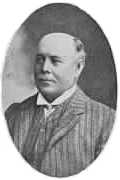Alexander Cameron (tramways administrator)
| Alexander Cameron | |
|---|---|
 Alexander Cameron in 1908 | |
| Born |
5 August 1864 Hamilton, Victoria |
| Died |
23 February 1940 (aged 75) South Yarra, Victoria |
| Nationality | Australian |
| Occupation |
Lawyer Local Councillor Tramways administrator |
Alexander Cameron (5 August 1864–23 February 1940)[1] was the first chairman of the Melbourne and Metropolitan Tramways Board, and established what was to become the world's largest urban electric tramway network.[2]
Cameron was born on a sheep station near Hamilton, Victoria. He attended Hamilton College and then studied law at the University of Melbourne, qualifying in 1886. He set up a legal firm with Samuel Crisp in 1889.[3] After marrying Mary Wright, they settled in the Melbourne suburb of Malvern.
Cameron became active in local government and in 1902 he was elected to the Malvern Town Council. He was an advocate for public transport, especially electric trams, and used his business and legal skills to help the council establish a tramway to link Malvern with Prahran. In 1907 the Prahran and Malvern Tramways Trust was begun, and in 1908 Cameron was made its chairman. Over the next few years under his leadership the trust extended its tramway network and finally covered seven suburbs.
In 1919 the Victorian Government decided to amalgamate the numerous tramway and cable car companies into a uniform public transport network. The government also wanted the cable cars system converted into an electric tramway. Cameron was appointed as the first chairman of the Melbourne and Metropolitan Tramways Board in 1919.[4] He travelled overseas to see what other countries were doing to provide quick and efficient public transport.[5] He pushed for an extended electric tramway throughout the city of Melbourne and its suburbs. He was opposed by the City of Melbourne[6] and various town planning groups that believed that noisy trams would hold up traffic, and that the electric wires and poles were an eyesore.[7]
Cameron was able to build the MMTB into the world's largest electric tramway network. The organization did everything from making uniforms to building tramcars to laying tracks. He made sure that any surplus funds were spent on developing more infrastructure.
Cameron remained chairman of the MMTB until he retired in 1935, he was succeeded in by Hector Hercules Bell.[8][9] He died in South Yarra in 1940.[1]
References
| Wikimedia Commons has media related to Alexander Cameron. |
- ↑ 1.0 1.1 Thomson, Kathleen (1979). "Cameron, Alexander (1864–1940)". Australian Dictionary of Biography. Canberra: Australian National University. Retrieved 8 July 2013.
- ↑ "Yarra Trams – Facts & figures". yarratrams.com.au. 2013. Retrieved 8 July 2013.
- ↑ "Alex Cameron – father of Melbourne's electric trams". pandora.nla.gov.au. 2010. Retrieved 8 July 2013.
- ↑ "Prahran-Malvern Tramway Trust Chairmanship.". Malvern Standard (Vic. : 1906 – 1931) (Vic.: National Library of Australia). 25 October 1919. p. 3. Retrieved 22 July 2013.
- ↑ "PERSONAL: Alexander Cameron obituary". The Advertiser (Adelaide, SA : 1931 – 1954) (Adelaide, SA: National Library of Australia). 24 February 1940. p. 16. Retrieved 22 July 2013.
- ↑ "COLLINS STREET TRAMS.". The Argus (Melbourne, Vic. : 1848 – 1957) (Melbourne, Vic.: National Library of Australia). 5 October 1928. p. 7. Retrieved 22 July 2013.
- ↑ "NOISY TRAMS DISTURB CHURCH-GOERS.". The Argus (Melbourne, Vic. : 1848 – 1957) (Melbourne, Vic.: National Library of Australia). 11 August 1934. p. 23. Retrieved 22 July 2013.
- ↑ Jones, Russell (2008). "Hector Hercules Bell – ringing in the new". Friends of Hawthorn Tram Depot. Retrieved 5 November 2014.
- ↑ McCalman, Janet (1993). "Bell, Hector Hercules (1876–1964)". Australian Dictionary of Biography. Retrieved 5 November 2014.